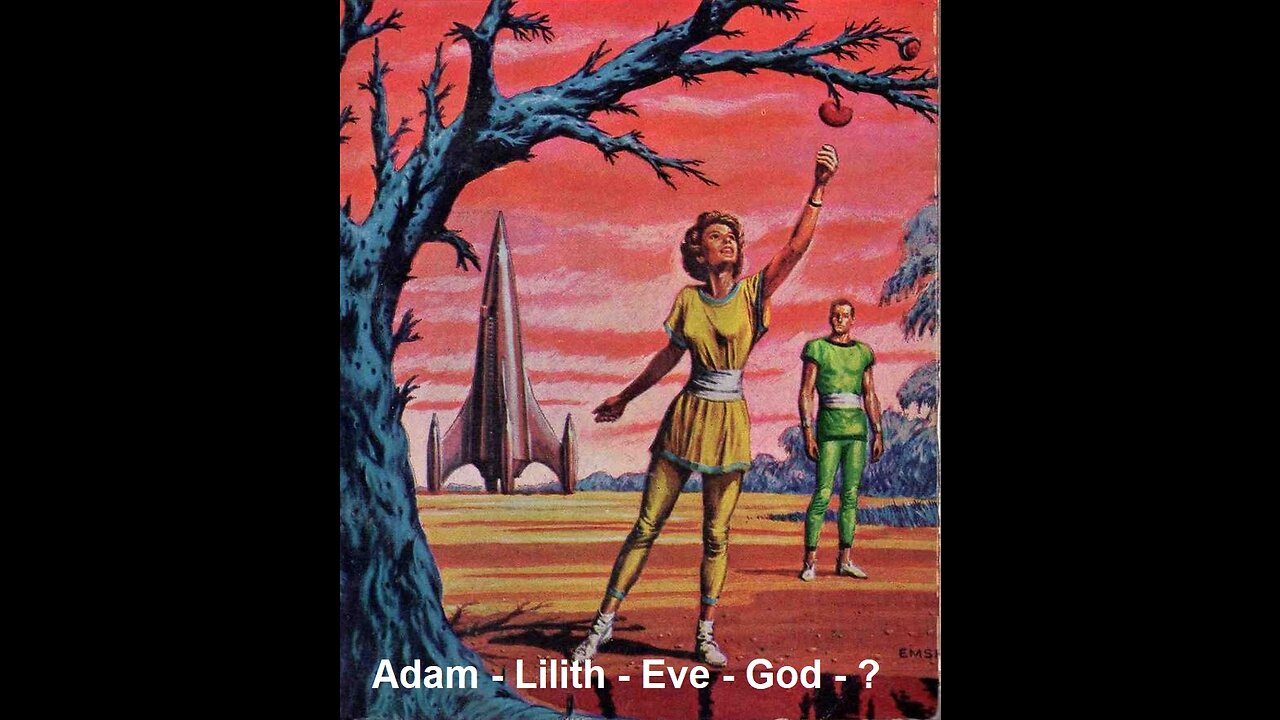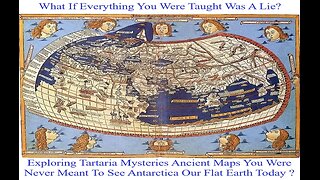Premium Only Content

Who is Adam’s (XY) first wife? Who is Lilith (YY)? Who is Eve (XX) ? Who is God (XYX) ?
First woman on earth Is Lilith not Eve ? - So In the Jewish\Hebrew mythology it says: that woman Lilith is the first woman on earth created by God before God created Eve, and Adam's first wife, she created by god from the same dust with Adam , Lilith also as known as the goddess of the night & darkness, also related to demon or monster.
In Hebrew-language texts, the term lilith or lilit (translated as "night creatures", "night monster", "night hag", or "screech owl") first occurs in a list of animals in Isaiah 34:14, either in singular or plural form according to variations in the earliest manuscripts. In the Dead Sea Scrolls 4Q510-511, the term first occurs in a list of monsters. In Jewish magical inscriptions on bowls and amulets from the 6th century CE onwards, Lilith is identified as a female demon and the first visual depictions appear.
The story of the prophets is certainly always a good example for our life today. So learn to understand the various wisdom of their life would be very useful for us.
Prophet Adam (A.S.) was the first man descended by Allah to earth, along with his wife named Hawwa (Eve). Adam belongs to the 25 prophets mentioned in the Quran.
According to different narrations by different Islamic Scholars, Adam lived for about 1000 years after creation. Prophet Adam has been mentioned in The Quran in several Verses, among them Verses from 30 to 38 of Surah Al-Baqarah (2nd Surah of Quran) and verses from 11 to 25 of Surah Al-A'raaf (7th Surah of Quran). The children of Adam and Eve were born twins, that is, every baby boy was born together with a baby girl.
The statement the angels uttered was not a form of disputing neither with Allah’s decision, nor out of envy for the Children of Adam or as some mistakenly thought. Allah has described Angels as those who do not precede Him in speaking, meaning that they do not ask Allah anything without His permission. When Allah informed them that He was going to create a creation on the earth and they had knowledge, angel’s only concern was that this creation (human) would commit mischief on earth.
In this verse, Allah’s words "Indeed, I know that which you do not know" means, "I know the benefit of creating this type of creature outweighs the harm that you mentioned, that which you have no knowledge of. I will create among them Prophets and send Messengers. I will also create among them truthful, martyrs, righteous believers, worshippers, the modest , the pious, the scholars who spread their knowledge to humble people and those who love Allah and follow His Messengers.''
Prophet Adam (A.S.) was created directly from the hands of Allah from clay and his soul was immediately blown by the Almighty Himself. In addition, the Prophet Adam (A.S.) was also equipped with the intellect that makes him able to learn, observe and understand things.
Allah stated the virtue of Adam above the angels, because He taught Adam, rather than them, the names/knowledge of everything, that is, the names that people use, such as human, animal, sky, earth, land, sea, including the names of the other species. This occurred after Angels prostrated to Adam. This discussion proceeds only to show the importance of Adam’s position, and the absence of the angel’s knowledge about creating the Khalifah when they asked about it. This shows the Adam's superiority over Angels in knowledge.
Bible Story of Adam and Eve
This is a summary of the Biblical account of Adam and Eve. You can read more in-depth Bible verses from the Scripture below and use the articles and videos to understand the meaning behind this teachable event in the Bible. God created the first man Adam and then created the first woman, Eve. God put Adam and Eve in the Garden of Eden to care for and nurture the land. He told Adam and Eve that they could eat from any fruit from the trees except for the tree of good and evil. God warned them that if they ate from the tree, they would die.
Bible Meaning of Adam
"Adam" is both the proper name of the first human and a designation for humankind. God himself gave this appellation to Adam and Eve (Gen 5:1-2). The color red lies behind the Hebrew root adam This may reflect the red soil from which he was made.
Adam was formed from the ground (Gen 2:7). Wordplay between "Adam" and "ground" (adama [h'm'd}a]) is unmistakable. It is essential that Adam is identified with humankind rather than any particular nationality. The country from which the dust was taken is not specified. Rabbis believed it came from all over the earth so no one could say, "My father is greater than yours."
The word "formed" suggests the careful work of a potter making an exquisite art piece. Into this earthen vessel, God breathed the breath of life (Gen 2:7). These words describe vivid intimacy between God and man not shared by animals.
Adam was made a little lower than "angels" (or "God") at his creation and "crowned with glory and honor" (Psalm 8:5). (Rabbis speculated the glory of Adam's heel outshone the sun.) He was commissioned as a vassal king to rule over God's creation. The words "subdue, rule, under his feet" (Gen 1:28; Psalm 8:6) suggest kingship over nature but not over his fellow man.
Bible Meaning of Eve
Eve was the name given in Scripture to the first woman. The account of Eve's creation is found at (Genesis 2:21, Genesis 2:22) Perhaps that which we are chiefly intended to learn from the narrative is the foundation upon which the union between man and wife is built, viz., the identity of nature and oneness of origin. Through the serpent's subtlety, Eve was beguiled into a violation of the one commandment given to her and Adam. The Scripture account of Eve closes with the birth of Seth.
The Tree of Life in the Garden of Eden
We’re not explicitly told that Adam and Eve could not or did not eat of the Tree of Life that was in the midst of the garden. But it would seem that the fruit of this tree was a feast that Adam and Eve would enjoy once they passed the test of obedience represented in the forbidden tree. Revelation 2:7 speaks of eating the tree of life being granted to those who “overcome” or “conquer.” Clearly, Adam and Eve did not overcome temptation. They were meant to rule over creation but couldn’t rule over their appetites. Because of their disobedience, they were barred from eating of the tree.
Revelation 22 reveals that the opportunity for God’s people to eat the tree of life is not gone forever. Instead, the tree of life is gloriously planted in the center of the greater garden to come. In Eden, the trees bore fruit in their season, which means once a year. But in the new and better Eden, the tree of life yields a new crop of fruit every month. In Eden, the tree of life grew in the midst of the garden. But in the new Eden, the tree of life grows on either side of the river. It seems to have multiplied and expanded, implying that everyone will have access to it; all will be welcome to eat their fill. And it’s not just the fruit that will feed us; the leaves of this tree will heal us. In fact, they will heal everything.
Sometimes we hear the story of the Bible told as Creation-Fall-Redemption-Restoration. But as good as Eden was, we’re not merely headed back to Eden as it once was. The story of the Bible is Creation-Fall-Redemption-Consummation. We’re looking forward to a home that will be even better than Eden (Excerpt from Bible Study)
The Serpent in the Garden of Eden
One day Satan came disguised as a snake and spoke to Eve, convincing her to eat the fruit from the tree of good and evil. Eve told the serpent that God said they should not eat it and they would die if they did, but Satan tempted Eve to eat saying that she would become like God if she did. Eve believed the lie and took a bite of the fruit. She then gave some to Adam for him to eat. Adam and Eve, now knowing that they had sinned, immediately felt ashamed and tried to hide from God.
Read more about the story of Adam and Eve, their lives in the Garden of Eden, how sin entered the world, and the consequences of disobeying God.
The book of Genesis mentions three of Adam and Eve's children: Cain, Abel and Seth.
But geneticists, by tracing the DNA patterns found in people throughout the world, have now identified lineages descended from 10 sons of a genetic Adam and 18 daughters of Eve.
The human genome is turning out to be a rich new archive for historians and prehistorians, one whose range extends from recent times to the dawn of human existence.
Delvers in the DNA archive have recently found evidence for a prehistoric human migration from Western Asia to North America; identified the people who seem closest to the ancestral human population; and given substantial weight to the whispers, long dismissed by historians, that Thomas Jefferson fathered a family with his slave Sally Hemings.
A new history of Britain and Ireland by Norman Davies, "The Isles," (Oxford University Press) begins with an account of Cheddar man, an 8,980-year-old skeleton from which mitochondrial DNA was recently extracted.
The DNA turned out to match that of Adrian Targett, a teacher in a Cheddar Village school, proving a genetic continuity that, despite numerous invasions, had endured through nine millenniums.
Unlike the DNA test used in forensic cases, which is designed to identify individuals, DNA analysis that seeks to reach back in time usually focuses on lineages, not individuals. From patterns in the DNA data, biologists can often estimate the sizes of ancient populations and even the approximate dates when one group of people split from another.
Though DNA can bear on historical questions, often by acting as a long-range paternity test, its most spectacular use has been in prehistory, where it has added a new dimension to the bare framework provided by archaeology.
The most detailed human family tree so far available is one constructed over many years by Dr. Douglas C. Wallace and his colleagues at the Emory University School of Medicine in Atlanta. Dr. Wallace's tree is based on mitochondrial DNA, tiny rings of genetic material that are bequeathed only by the egg cell and thus through the maternal line.
A counterpart tree for men, based on analysis of the Y chromosome, has been prepared by Dr. Peter A. Underhill and Dr. Peter J. Oefner of Stanford University.
Population geneticists believe that the ancestral human population was very small -- a mere 2,000 breeding individuals, according to a calculation published last December. But the family tree based on human mitochondrial DNA does not trace back to the thousand women in this ancestral population. The tree is rooted in a single individual, the mitochondrial Eve, because all the other lineages fell extinct.
The same is true of the Y chromosome tree, a consequence of the fact that in each generation some men will have no children, or only daughters, so the number of different Y chromosomes may steadily diminish, even if the population stays the same size.
This ancestral human population lived somewhere in Africa, geneticists believe, and started to split up some time after 144,000 years ago, give or take 10,000 years, the inferred time at which both the mitochondrial and Y chromosome trees make their first branches.
Mitochondria, which live inside human cells but outside the nucleus, escape the shuffling of genes that occurs between generations and are passed unchanged from mother to children.
In principle, all people should have the same string of DNA letters in their mitochondria. In practice, mitochondrial DNA has steadily accumulated changes over the centuries because of copying errors and radiation damage.
Because women were steadily spreading across the globe when many of these changes occurred, some changes are found only in particular regions and continents.
Dr. Wallace discovered that almost all American Indians have mitochondria that belong to lineages he named A, B, C and D. Europeans belong to a different set of lineages, which he designated H through K and T through X. The split between the two main branches in the European tree suggests that modern humans reached Europe 39,000 to 51,000 years ago, Dr. Wallace calculates, a time that corresponds with the archaeological date of at least 35,000 years ago.
In Asia there is an ancestral lineage known as M, with descendant branches E, F and G as well as the A through D lineages also found in the Americas.
In Africa there is a single main lineage, known as L, which is divided into three branches. L3, the youngest branch, is common in East Africa and is believed to be the source of both the Asian and European lineages.
Dr. Wallace's mitochondrial DNA lineages are known technically as "haplogroups" but more colloquially as "daughters of Eve," because all are branches of the trunk that stems from the mitochondrial Eve.
The Y chromosome tree has not yet been published by the Stanford researchers, but in a book that came out in March, "Genes, People and Languages," a colleague at the university, Dr. Luca Cavalli-Sforza, sketched a preview of the findings.
The tree is rooted in a single Y chromosomal Adam, and has 10 principal branches, Dr. Cavalli-Sforza reports.
Of these sons of Adam, the first three (designated I, II and III) are found almost exclusively in Africa. Son III's lineage migrated to Asia and begat sons IV-X, who spread through the rest of the world -- to the Sea of Japan (son IV), northern India (son V) and the South Caspian (sons VI and IX).
Dr. Cavalli-Sforza believes these Y chromosome lineages may be associated with the major language groups of the world. The South Caspian population, for example, may have spoken Eurasian, the ancestral tongue of Indo-European (to which English belongs) and most of the continent's other major language families.
But Dr. Wallace, asked if his mitochondrial DNA lineages also corresponded to the world's major language groups, said he "tended to be more cautious than Luca."
Dr. Wallace has recently been exploring the root of the mitochondrial tree. In an article published in March in The American Journal of Human Genetics, he and colleagues identify the Vasikela Kung of the northwestern Kalahari desert in southern Africa as the population that lies nearest to the root of the human mitochondrial DNA tree. Another population that seems almost equally old is that of the Biaka pygmies of Central Africa.
Both peoples live in isolated regions, which may be why their mitochondrial DNA seems little changed from that of the ancestral population. "We are looking at the beginning of what we would call Homo sapiens," Dr. Wallace said.
One of the most vexed issues in human prehistory is the timing and number of migrations into the Americas. Dr. Joseph Greenberg, a linguist at Stanford University, has proposed three migrations, corresponding to the three language groups of the Americas, known as Amerind, Na-Dene and Eskimo-Aleut. Dr. Wallace's mitochondrial DNA data broadly support this general thesis, though the arrival of the Amerind-speakers seems more complex than a single migration.
Of the A through D lineages found in American Indians, A, C and D also occur in Siberian peoples, suggesting that their ancestors were the principal source of the Amerind-speakers' migration. But the B lineage, though it is found elsewhere in Asia, has not turned up in Siberia, a hint that the B people may have taken a sea route to the Americas and then merged there with their A- , C- and D-carrying cousins.
In 1998, Dr. Wallace and his colleagues discovered the X pattern, a rare European lineage, among the northern Native Americans such as the Ojibwa and Sioux. At first they assumed it came from intermarriage with modern Europeans. But the American X lineage turned out to be pre-Columbian and its owners would have arrived in America either 15,000 or 30,000 years ago, depending on certain genetic assumptions.
The European X lineage seems to have originated in Western Asia around 40,000 years ago. Dr. Wallace suggests a part of this group may have made their way to America via Siberia, even though no traces of the X-lineage have yet turned up in eastern Asia. A trans-Atlantic route is a possible alternative.
When modern humans first started to leave Africa, about 50,000 years ago by present reckoning, they probably consisted of small groups of hunter-gatherers a few hundred strong.
In their determined exploration of the world before them, they must have overcome, with the primitive means at their disposal, the extreme rigors of climate, terrain and perhaps the archaic human populations like the fearsome Neanderthals who had preceded them out of Africa.
The biologist Edward O. Wilson, in a recent interview with The Wall Street Journal, mused that a new basis for spiritual values might be found -- not in the usual religious sources but in what he sees as the inspiring story of human origins and history.
"We need to create a new epic based on the origins of humanity," he said, adding: "Homo sapiens have had one hell of a history! And I am speaking both of deep history -- evolutionary, genetic history -- and then, added on to that and interacting with it, the cultural history recorded for the past 10,000 years or so."
Many of the biologists who are reconstructing the human past certainly believe their work has a value that transcends genetics.
Although their lineage trees are based on genetic differences, most of these differences lie in the regions of DNA that do not code for genes and have no effect on the body.
"We are all Africans at the Y chromosome level and we are really all brothers," Dr. Underhill said.
Dr. Wallace remarked that since he started working on mitochondrial DNA in the late 1970's: "What I have found astounding is that it clearly shows we are all one human family. The phylogeny in Africa goes back to the origins of our species, but the fingers of L3 are touching Europe and Asia, saying that we are all closely related."
Whether or not genetic prehistory is suitable material for a modern origin myth, it is about to be made available to a wider public.
Last month a company called Oxford Ancestors set up business with the offer to tell customers which of the seven daughters of Eve they are descended from. (Almost all Europeans belong to only seven of the nine mitochondrial lineages found in Europe).
The company's founder is Dr. Bryan Sykes, a human geneticist at the University of Oxford in England. On the reasonable basis that the founders of Dr. Wallace's mitochondrial DNA lineages were real women, Dr. Sykes gave them names and sketched in details of their likely dates and origin. Thus people found to belong to haplogroup U will be told they are descended from Ursula, who lived about 45,000 years ago in Northern Greece. Ancestor of the X's is Xenia, who lived 25,000 years ago in the Caucasus mountains.
As if fulfilling Dr. Wilson's suggestion, Dr. Sykes said he had "worked out a mythological framework for these seven women," in respect of the arduous times in which they must have lived and the triumph of spreading their mitochondrial DNA to almost all the inhabitants of Europe.
He is now working on tests to identify other lineages around the world, including 14 in Africa, and 16 in Eurasia and the Americas. "I don't think this stuff should be confined to academics," he said.
The book of Genesis mentions three of Adam and Eve's children. But geneticists, by tracing the DNA patterns found in people throughout the world, have now identified lineages descended from 10 sons of a genetic Adam and 18 daughters of Eve.
The most detailed human family tree so far available is one constructed over many years by Dr. Douglas Wallace and his colleagues at the Emory University School of Medicine in Atlanta. Wallace's tree is based on mitochondrial DNA, tiny rings of genetic material that are bequeathed only by the egg cell and thus through the maternal line.
Population geneticists think the ancestral human population was very small - a mere 2,000 breeding individuals, according to a calculation published last December. But the family tree based on human mitochondrial DNA does not trace back to the thousand women in this ancestral population. The tree is rooted in a single individual, the mitochondrial Eve, because all the other lineages fell extinct.
The same is true of the Y chromosome tree, a consequence of the fact that in each generation some men will have no children, or only daughters, so the number of different Y chromosomes may steadily diminish, even if the population stays the same size.
This ancestral human population lived somewhere in Africa, geneticists think, and started to split up some time after 144,000 years ago.
Wallace discovered that almost all Native Americans have mitochondria that belong to lineages he named A, B, C and D. Europeans belong to a different set of lineages, which he designated H through K and T through X. The split between the two main branches in the European tree suggests that modern humans reached Europe 39,000 to 51,000 years ago.
In Asia, there is an ancestral lineage known as M, with descendant branches E, F and G as well as the A through D lineages also found in the Americas.
In Africa, there is a single main lineage, known as L, which is divided into three branches. L3, the youngest branch, is common in East Africa and is thought to be the source of both the Asian and European lineages.
Wallace's mitochondrial DNA lineages are known technically as "haplogroups" but more colloquially as "daughters of Eve," because all are branches of the trunk that stems from the mitochondrial Eve.
It is widely believed that Buddhism was introduced to China during the Han period (206 B.C.- A.D. 220). Buddhism entered China, perhaps as early as the first century B.C., from India and Central Asia via the Silk Road trade route, along which goods were traded between China and the Roman Empire and cultures from China merged with those of India, Central Asia and Iran. Artifacts from Kushan — a Greek-influenced, Pakistan-based, Buddhist civilization — have been found in western China. In the A.D. 1st century Buddhism caught they eye of the Han Emperor Wu, who sent a mission to India which returned in A.D. 67 with Buddhist scriptures, two Indian monks and several Buddhist images. By the end of the A.D. 1st century there was a Buddhist community in the Chinese capital of Loyang.
Buddhism didn't really begin to have an influence on China until the A.D. 2nd century, when Buddhist monks and translator-missionaries from India and Central Asia began arriving in larger numbers overland along the Silk Road and by sea on trade routes between India and China via Southeast Asia. The first Buddhist monks arrived with shaven heads, begging bowls and robes at a time when the only people in China that dressed and acted in such a manner were criminals and beggars. These monks, traveling alone and in pairs, had nether homes nor families — concepts that defied traditional Confucian emphasis on family, honoring ancestors and producing heirs. The earliest Buddhist monasteries in China were run primarily by Chinese-speaking Indians and Central Asians. As their Chinese students matured Chinese took over the monasteries and Buddhist texts translated to Chinese became the main texts.
Buddhism arrived in China at roughly the same time Christianity was spreading from Palestine into the Roman Empire. Unlike Christianity in Europe, Buddhism in China was never able to wipe out traditional moral and religious beliefs that existed before it. At first Buddhism was viewed as just another Taoist sect. Stories circulated that the Taoist founder Lao-tze emigrated to the West and became a teacher of The Buddha or became The Buddha himself.
There have been periods where Buddhists in China have been persecuted. Perry Garfinkel wrote in National Geographic: “In China, in A.D. 842, the Tang Emperor Wuzong began to persecute foreign religions. Some 4,600 Buddhist monasteries were annihilated, priceless works of art were destroyed, and about 260,000 monks and nuns were forced to return to lay life. History repeated itself with the Chinese Communist Party's attempt to suppress Buddhism — most visibly in Tibet. According to the International Campaign for Tibet, since 1949 more than 6,000 Tibetan Buddhist monasteries, nunneries, and temples have been destroyed and at least 500,000 Tibetans have died from imprisonment, torture, famine, and war. But today Buddhism in China, like the lotus flower that emerges from mud, is resurfacing. With more than 100 million practitioners, it's one of the country's fastest growing religions. [Source: Perry Garfinkel, National Geographic, December 2005]
The Y chromosome tree has not yet been published by the Stanford researchers.
Sex Chromosomes Definition
Sex chromosomes are chromosomes that determine whether the individual is male or female. Though these two chromosomes pair with each other during meiosis, there is usually very minimal homology or recombination between them, primarily because of a large difference in their genetic content and size. Often one chromosome is smaller, and appears to retain only those genes that are necessary for sex determination.
In evolutionary timescales, the appearance of distinctly different sex chromosomes, or heteromorphic sex chromosomes, is a relatively recent event. The first instances of sexual dimorphism, where male and female reproductive organs are in different individuals, are thought to have arisen through temperature-dependent sex determination, where some genes are turned on or off depending on the ambient temperature. These genes give rise to the external male or female characteristics and some species of lizards continue to use this method. Over time, this is supposed to have evolved into the system of different sex chromosomes.
Other methods of sex determination include haplodiploidy – where males develop from unfertilized eggs, and therefore have only one set of chromosomes, and females are diploid. Bees, ants and wasps are all common examples where male drones are haploid and the female worker bees are diploid. Komodo dragons can even preferentially produce males through parthenogenesis.
Types of Sex Chromosomes
There is a wide variety of forms that sex chromosomes can take and a number of ways in which sex determination can occur. The two major ways in which heteromorphic sex chromosomes can determine sex are known as the XY and ZW systems.
X and Y Chromosomes
In the XY system, males contain one X and one Y chromosome, while females contain two X chromosomes. Thus, males are considered heterogametic – they can produce two different types of gametes, depending on whether the sperm carries an X or a Y chromosome. Females are homogametic – all their eggs carry one X chromosome. Many primates, including humans, use the XY sex-determination system.
A variant of this is the method used by some grasshoppers. Here, males have only one X chromosome and no Y chromosome. In such systems, it is believed that a male or female develops based on the ratio between X chromosomes and the number of sets of autosomes. For instance, if a diploid individual has two X chromosomes, it develops into a female, while males arise from diploids who have one X chromosome. The impact of ratios is particularly important in sex determination in fruit flies Drosophila melanogaster and roundworms C. elegans where XXY or XXYY individuals are females and XO individuals are male. This is in contrast to the case in humans where the mere presence of one Y chromosome confers maleness, irrespective of the number of X chromosomes or the ratio between sex chromosomes and autosomes.
Until recently, there was widespread belief that the Y chromosome in primates is undergoing rapid gene loss and that the chromosome would completely disappear in about ten million years, leading primates to an XX/XO system of sex determination. This is now being contested and research into the evolution of sex chromosomes is leading to new discoveries.
W and Z Chromosomes
Birds, some fishes, reptiles and even some invertebrates undergo sex determination by the ZW method. Here the males are homogametic (ZZ) and the females carry two different sex chromosomes (ZW). Occasionally the W chromosome can be completely absent, such as in some species of butterflies, and ZO develop into females. In others, the presence of a W chromosome isn’t even necessary for the development into females.
Sex Chromosomes in Flowering Plants
For most flowering plants, or angiosperms, the male and female sex organs are present on the same flower. Occasionally, a single plant may produce separate male and female flowers to enhance cross fertilization or the male and female sex organs may mature at different times. However, the presence of distinct male plants and female plants is relatively rare and only six percent of angiosperms show this characteristic, which is called dioecy. Even those that have this kind of sexual dimorphism rise due to male sterile or female sterile mutations and therefore distinct sex chromosomes are known only in four plant families.
It appears as if plants are in the early stages of evolution of heteromorphic sex chromosomes. Therefore they can be used as models to study the events that lead to chromosomal sex determination.
Accumulation of Harmful Mutations on the Y-Chromosome
Evolution of sex chromosomes is thought to arise through mutation of autosomes that carry sex determination genes. At some point, when there is clustering of genes for sex determination on one of the two autosomes, there is a suppression of recombination to ensure that the gene cluster is inherited in one block. Once this occurs, however, an incipient Y chromosome begins to form, by accumulating transposable elements, chromosomal rearrangements and other harmful mutations, that hitchhike with favorable sex-determination genes. This is said to lead to fully heteromorphic sex chromosomes and sex determination.
The inability of the Y-chromosome to auto-correct mutations through recombination during meiosis makes it particularly prone to accumulating errors. In addition, sperms are formed in large numbers, involving many cell division events, all of which enhance the chances of error accumulation. Sperm is also stored in a highly oxidative environment in the testes, again increasing the possibility of genetic mutation. One hypothesis states that these factors have contributed to a situation where the Y chromosome has lost most of its genes, except those that are crucial for sex determination and survival of the fetus. This leads to homogametic females having nearly double the number of genes on their sex chromosomes compared to their heterogametic partners. In some animals where the males are XY, gene expression on one of the X chromosomes in females is silenced through the formation of heterochromatin. Alternatively, some insects choose to over express the genes on their X chromosome in the heterogametic individuals. This modification of gene expression is called dosage compensation. Recently, dosage compensation has also been observed for the first time in the dioecious plant S.latifolia, or while campion.
Genetic Disorders in Sex Chromosomes
Heterogametic individuals are more susceptible to genetic disorders involving the sex chromosome because they receive only one copy of each gene. For instance, if the mother is a carrier for a recessive genetic disorder, she has a fifty percent chance of passing on the illness to her male child, depending on which allele gets retained in the egg. On the other hand, none of her daughters is likely to be affected, because they would inherit another X chromosome from their father which would have the normal allele.
One major historical event was precipitated by an X-linked genetic disorder. The hemophilia of Alexis Nikolaevich, the son of the last Tsar of Russia, was inherited from his mother. The initial mutation originated in Queen Victoria and, through her daughters, it spread to many royal families in Europe. It is believed that Alexis’ ailment contributed to the fall of Russian monarchy.
In this image, carriers are colored pink and hemophiliacs are colored red. It shows the transfer of the hemophilia allele from Queen Victoria to one son and two daughters. Thereafter, three grandsons and four granddaughters inherited the allele. Through marriage, the diseased allele was passed on to royal families in Germany, Spain and Russia.
Other X-linked disorders include color blindness which is seen much more often in males. Additionally, any mutations on the Y chromosome are also inherited by male progeny without any chance of recombination or change. Y-linked inheritance is associated with reduced fertility and baldness.
On the other hand, X-linked dominant disorders affect male and female progeny. A mother who carries an X-linked dominant disorder can pass on her illness to fifty percent of her daughters and fifty percent of her sons. A father will pass on his condition to all his daughters and none of his sons. However, these are rare events because the presence of dominant genetic anomalies severely reduces reproductive opportunities.
Occasionally, a nondisjunction event during meiosis leads to aneuploidy – the fertilized egg has an irregular set of chromosomes with some being present in multiple copies or being absent altogether. When this happens with sex chromosomes, it can lead to individuals who have an unusual set of X and Y chromosomes. For instance, some females have three X chromosomes and this condition is usually discovered when there are other symptoms, such as poor muscle tone or learning difficulties. On the other hand, females with only one X chromosome have Turner’s syndrome and suffer from a number of physical, reproductive, and neurological deficiencies. Klinefelter’s males are people with two X and one Y chromosome. This is among the most common sex chromosome aneuploidies in humans with a number of subtle and gross symptoms. The men are often sterile, are taller than average but have poor muscle tone and coordination. On the other hand, men who have an extra Y chromosome show increased height but no other symptoms.
Most cases of sex chromosome aneuploidy are discovered when the individuals show neurological symptoms, learning difficulties or infertility.
Related Biology Terms
Autosomes – Chromosomes that are not involved in sex determination.
Dioecious – Containing the male and female sex organs in different individuals; normally used to refer to plants and some invertebrate animals.
Nondisjunction – The failure of one or more pairs of homologous chromosomes or sister chromatids to separate during meiosis leading to aneuploidy.
Parthenogenesis – Process of asexual reproduction in some plants, invertebrates and reptiles where the egg can produce offspring without fertilization.
Polyploidy – The presence of more than two complete sets of chromosomes in a cell.
In 335 B.C.E., Aristotle proposed that the heat of the male partner during intercourse determined sex. At least in the case of reptiles, Aristotle was on to something. What about in other animals?
Whether an animal will become a male, a female, or a hermaphrodite is determined very early in development. Scientists have worked for hundreds of years to understand the sex-determination system. For instance, in 335 B.C.E., Aristotle proposed that the heat of the male partner during intercourse determined sex. If the male's heat could overwhelm the female's coldness, then a male child would form. In contrast, if the female's coldness was too strong (or the male's heat too weak), a female child would form. Environmental theories of sex determination, such as Aristotle's, were popular until about 1900, when sex chromosomes were discovered. As it turns out, Aristotle was on to something, at least in the case of some reptiles, in which the temperature of the nest determines the sex of the embryo. For most animals, however, sex is determined chromosomally.
Sex Chromosomes
Sex determination results in the development of individuals with characteristics that allow them to be identified as males, females, or in some cases, hermaphrodites. In certain species, like the solid nematode C. elegans, differences in sexual characteristics can be very small; in fact, in C. elegans, the only distinguishing sexual characteristic is the presence of a testis versus an ovotestis. In other species, the phenotypic differences between the sexes can be quite significant. Consider, for example, the remarkable plumage and display of a tom turkey versus the rather plain features of a female turkey. Female and male mammals are also readily distinguished by many differences in their internal and external phenotypes, behavior, and metabolism.
The first major breakthrough in understanding sex determination was the discovery of sex chromosomes in the early 1900s. From meticulous analyses of male and female insect chromosomes, scientists discovered that, although most chromosomes were present in equal numbers in both males and females, there were one or two additional chromosomes that were unequally represented in the two sexes. Analyses of additional species over the years has revealed that chromosomal differences are primarily responsible for sex determination in most animals.
Chromosomal Mechanisms of Sex Determination in Insects
Insects are the most diverse class of organisms on the planet, so it is not too surprising that they show considerable diversity in their mechanisms of sex determination (Saccone et al., 2002). However, like most other animals, the majority of insects have dimorphic sex chromosomes that can be distinguished cytologically.
Animals with two different sex chromosomes are of heterogametic sex, and they are thus able to produce two types of gametes. Conversely, members of the homogametic sex can only produce one type of gamete. In humans (as well as many other animals), males generally have one X and one Y chromosome, while females have two X chromosomes. This system is reversed in butterflies and moths (order Lepidoptera): females are the heterogametic sex, while males are homogametic. The sex chromosomes in Lepidoptera are designated W and Z. W chromosome is usually associated with the development of female characteristics. When the W chromosome is absent, ZZ develops into males and ZO develop into females. Having a W chromosome to develop as a female isn't even a necessity for some species. A moth known as Talaeporia tubulosa uses the ambient temperature to control sex determination in the absence of W chromosome. When temperatures are warm, the Z chromosome is found on the inner spindle and more female eggs are produced, whereas in colder conditions, the Z chromosome moves to the outer pole, resulting in greater production of males (Traut et al., 2007). This system corresponds to the adaptive advantage of favoring the production of female offspring when conditions are good (warm) and resources for their subsequent reproduction are more likely to be available.
Some grasshoppers also use a single-chromosome (XX/XO) sex determination system; here, males have only one sex chromosome, so they are considered to be XO. Thus, males are the heterogametic sex, because they produce two different kinds of gametes.
The system of chromosomal sex determination is even further reduced in certain genera of mosquitoes, in which the two sexes are chromosomally indistinguishable. Sex in this homogametic group is thought to be determined by a dominant male-determining factor.
Sex Determination in Drosophila
The sex chromosomes of the fruit fly Drosophila melanogaster have played a particularly important role in our understanding of heredity. Therefore, it may come as a surprise that fruit flies use a relatively rare mechanism to determine sex. In fact, in Drosophila, sex is primarily determined by the X:A ratio, or the ratio of the number of X chromosomes to the number of sets of autosomes (Cline & Meyer, 1996). The balance between female-determining factors encoded on the X chromosome and male-determining factors encoded on the autosomes determines which sex-specific pattern of transcription will be initiated. Thus, XX, XXY, and XXYY flies are females, while XY and XO flies are males. Flies are unable to survive with more than two copies of an X chromosome because of the mechanism that they use for dosage compensation. (Dosage compensation refers to the processes by which animals equalize the amount of gene products generated from X-linked genes in males and females. Unlike in mammals, all of the Drosophila X chromosomes remain active, and flies adjust the levels of X-linked gene products by doubling expression from the X chromosome in males. An extra copy of the X chromosome, which contains close to one-third of fly genes, creates an aneuploid condition that greatly disrupts the equilibrium in cells.)
Drosophila sex determination also differs from mammalian sex determination in several other ways. First, sex determination begins immediately at fertilization, and there is no indifferent period. Furthermore, hormones are not responsible for sex-specific traits; instead, each cell in the embryo senses the X:A ratio, triggering either the female- or male-specific pattern of transcription. Microarray experiments indicate that the sex-specific differences in gene expression are quite extensive. In fact, roughly 30% of Drosophila genes were found to show sex-specific biases in expression (Parisi et al., 2004).
Sex Determination in Mammals
In placental mammals, the presence of a Y chromosome determines sex. Normally, cells from females contain two X chromosomes, and cells from males contain an X and a Y chromosome. Occasionally, individuals are born with sex chromosome aneuploidies, and the sex of these individuals is always determined by the absence or presence of a Y chromosome. Thus, individuals with 47,XXY and 47,XYY karyotypes are males, while individuals with 45,X and 47,XXX karyotypes are females. Humans are able to tolerate supernumerary numbers of sex chromosomes because of X inactivation and the fact that the human Y chromosome is quite gene-poor.
Although the role of the Y chromosome in mammalian sex determination has been known since the early twentieth century, it was not until 1959 that scientists were able to identify the region of the Y chromosome that controlled this process (McLaren, 1991). Later, researcher David C. Page analyzed the chromosomes of sex-reversed XX men, rare individuals who look like men but have two X chromosomes instead of one X chromosome and one Y chromosome. Using DNA hybridization with probes corresponding to different regions of the Y chromosome, Page discovered that sex-reversed males carried genes from a 140-kilobase region on the short arm of the Y chromosome (Figure 1). Presumably, this region had been transferred to the X chromosome during a translocation (Page et al., 1985). Subsequent experiments narrowed down this region (McLaren, 1991) and found that one gene, the sex-determining region of the Y, or SRY, was the master regulator of sex determination. The presence of just this region from the Y chromosome is thus sufficient to cause male development (Koopman et al., 1991).
In human embryos, the SRY gene encodes a unique transcription factor that activates a testis-forming pathway at about week seven of development. Before this time, the embryonic gonad is "indifferent," meaning that it is capable of developing into either a testis or an ovary (Figure 2). Likewise, the early embryo has two systems of ducts, Wolffian and Müllerian ducts, which are capable of developing into the male and female reproductive tracts, respectively. Once the SRY gene product stimulates the indifferent gonad to develop into a testis, the testis begins producing two hormones, testosterone and anti-Müllerian hormone, or AMH. Testosterone and one of its derivatives, dihydrotestosterone, induce formation of other organs in the male reproductive system, while AMH causes the degeneration of the Müllerian duct. In females, who do not contain the SRY protein, the ovary-forming pathway is activated by a different set of proteins. The fully developed ovary then produces estrogen, which triggers development of the uterus, oviducts, and cervix from the Müllerian duct.
Sex Determination in Birds: Z and W Chromosomes
In birds, sex is determined by chromosomes known as the Z and W, and females are the heterogametic sex. Early on, it was apparent that there were notable differences in the mechanisms used for sex determination in birds and mammals. Working with chickens, scientists were unable to find a counterpart of the SRY gene required for mammalian testis determination, so they searched for homologues of other genes that were required for testis formation in mammals. These investigations led to the discovery of the DMRT1 gene on the chicken Z chromosome (Nanda et al., 1999).
In mammals, the DMRT1 gene product is a critical member of the testis-forming pathway initiated by SRY. Two copies of the DMRT1 gene are necessary for testis development, even in the presence of SRY. In mammals, both sexes have two copies of DMRT1, because it is located on an autosome (specifically, chromosome 9). In chickens, by contrast, only males possess two copies of DMRT1, as it is located on the Z chromosome. Figure 3 shows the results of an in situ hybridization experiment in which a DRMT1 probe has been hybridized to the chromosomes of a female chicken. Figure 3b shows the appearance of the chromosomes under a microscope, and Figure 3a shows that the DRMT1 probe hybridizes to a single region on the female's Z chromosome. (These are metaphase chromosomes, so hybridization is detected on the two sister chromatids.) Figure 3c shows selected chromosomes in a partial karyotype. One can readily see that the Z chromosome is significantly larger than the W chromosome.
The actual trigger for activating the testis-forming pathway in chickens remains unknown. Birds also differ significantly from mammals in that two unique genes on the W chromosome, FET1 and ASW, are necessary for female development. The function of FET1 is unknown, but it is expressed in the gonads leading up to the time of sexual differentiation (Smith & Sinclair, 2004). Like mammals, chickens also have an indifferent gonad until around day four of development, after which an ovary or a testis starts to develop. Hormones then orchestrate the development of other sex-specific characteristics. In contrast with mammals, however, estrogen is required earlier in sex determination in chickens, and is, in fact, necessary for formation of the ovary. In fact, genetically male chickens can be converted to females if eggs are injected with estrogen at the sensitive stage of development.
The ZZ-ZW mechanism of sex determination is not restricted to birds. Within the vertebrates, a similar system of sex determination has been identified in reptiles, as well as in some fishes and amphibians.
Sex Determination and Environment
As previously mentioned in the discussion of Talaeporia tubulosa, environmental factors can sometimes play an important role in sex determination. Insects are not a special case—among the vertebrates, temperature also has a strong influence on sex determination in certain groups of reptiles. For example, in crocodilian reptiles and most turtles, sex is determined by egg incubation temperature. There are several variations on this theme. In the alligator snapping turtle, Macroclemys temminckii, incubation of eggs below 22°C or above 28°C gives rise to females, while incubation at intermediate temperatures produces predominantly males. American alligators show a similar biphasic dependence on temperature, but the curve is shifted to higher temperatures. In the European pond turtle, Trachemys scripta, incubation temperatures above 30°C produce all females, whereas incubation temperatures below 25°C produce all males. At 28.5°C, equal numbers of males and females are produced.
The temperature-dependent component of the sex-determination pathway has been studied in great detail in the European turtle, Emys orbicularis. In E. orbicularis, the critical temperature-dependent component appears to be synthesis of the enzyme aromatase, which converts androgens, such as testosterone, into estrogens. At higher temperatures, increased aromatase activity produces more estrogens, which biases the sex ratio toward more females.
As one compares the various mechanisms for sex determination among species, it is clear that evolution has produced numerous solutions for generating different sexes. Sexual reproduction has tremendous adaptive value to a species, because it introduces new genetic variability into a population in each new generation. Chromosomes play determinative roles in most species, but even so, environmental factors introduce additional wrinkles into the developmental process.
Most people have 46 chromosomes in each cell. In males, this typically includes one X chromosome and one Y chromosome (XY). XYY syndrome is a genetic condition that occurs when a male has an extra copy of the Y chromosome in each of their cells (XYY). Sometimes, this mutation is only present in some cells. Males with XYY syndrome have 47 chromosomes because of the extra Y chromosome.
This condition is also sometimes called Jacob’s syndrome, XYY karyotype, or YY syndrome. According to the National Institutes of Health, XYY syndrome occurs in 1 out of every 1,000 boys.
For the most part, people with XYY syndrome live typical lives. Some may be taller than average and face learning difficulties or speech problems. They may also grow up with minor physical differences, such as weaker muscle tone. Besides these complications, though, males with XYY syndrome don’t usually have any distinguishing physical features, and they have normal sexual development.
Most people are born with 46 chromosomes that are divided into 23 pairs. Chromosome pairs carry genes from each parent, which determine a person’s physical characteristics, like their height or eye color. The 23rd pair of chromosomes determine whether a person is born male or female. People who are born female usually have two X chromosomes.
Triple X syndrome (also called trisomy X syndrome, XXX syndrome, or 47,XXX) is a rare genetic condition where females inherit an extra X chromosome. For some females with triple X syndrome, the third X chromosome can be found in every cell in their body. For others, it is only found in some of their cells.
Triple X syndrome is thought to affect about 1 out of every 1,000 female babies born. This number could potentially be much higher because many women with the condition might not ever be diagnosed if they do not have any obvious physical symptoms or developmental problems.
Here is what you need to know about what causes triple X syndrome, its symptoms, and how it is diagnosed and treated.
What Causes Triple X Syndrome?
Triple X syndrome is congenital, which means that people with the condition are born with it. It affects only females and happens when an extra X chromosome is inherited.
Women who are over age 35 when their babies are born might have an increased risk of giving birth to a daughter with triple X syndrome.
Triple X syndrome happens either when there is a problem with the sperm or egg during conception or because of an error in cell division during the embryo’s early stages of development.
If triple X syndrome happens during early development, the baby might be born with a mosaic form of the condition. Mosaicism happens when some cells have two regular X chromosomes, but others have three. The percentage of cells with three X chromosomes can be different for each person with triple X syndrome.
Triple X syndrome is random and unpreventable. Even if you have a triple X chromosome, it won't usually be passed down to your children.
Hermaphrodite
Hermaphroditism is the condition of having both male and female reproductive organs. The term hermaphrodite was once commonly used in medical and informal contexts to refer to people but this use is no longer accepted.
Doctor Exposes Transgender Propaganda Movement Industry Is Existence Pronouns - https://rumble.com/v2ibeey-doctor-exposes-transgender-propaganda-movement-industry-is-existence-pronou.html
How Many Genders Are There XX-XY-XYX-YX-YY And AI-Robots Inclusive Pronouns ? - https://rumble.com/v2iemq4-how-many-genders-are-there-xx-xy-xyx-yx-yy-and-ai-robots-inclusive-pronouns.html
Lesbians Raped Or Forced 2 Sex By Trans Men - Fight Between Trans And Feminists - https://rumble.com/v2ic25q-lesbians-raped-or-forced-2-sex-by-trans-men-fight-between-trans-and-feminis.html
Islamic Transgender Muslims In Pakistan Frequently Asked Questions Transgender People - https://rumble.com/v2icdks-islamic-transgender-muslims-in-pakistan-frequently-asked-questions-transgen.html
The Electric Prunes - Mass in F Minor - Om is the Primordial Sound of the Universe - https://rumble.com/v2iaxe2-the-electric-prunes-mass-in-f-minor-om-is-the-primordial-sound-of-the-unive.html
So is genders in your mind only... I do not feel like a man or trans or woman... I'm only a human being in heart - mind - body - love - peace of mind - and i care for all lives and living things on this earth and follow the golden rules of life and peace be with you always in this world. Om is the seed of transcendental sound, and it is through transcendental sound one can transform the mind and the senses. By chanting Om, the mind becomes aligned with the breath, which enables a person to get into an elevated state of consciousness called samadhi. "How sweet to be a Cloud, floating in the Blue !" Samadhi is the highest state of mental concentration that people can achieve while still bound to the body and which unites them with the highest reality. https://youtu.be/8Yqr4UK41GM and Garden Of Earthly Delights - https://youtu.be/RH5CI60S-8k and - Journey to the Center of the Mind - https://youtu.be/_onagRhKN5E and - Shades Of Green And Grey - https://youtu.be/NSX9cFHYS60 and - A Change On The Way - https://youtu.be/HPZT2KeJHmM - I hope this will helps everyone in life.
-
 2:19:00
2:19:00
What If Everything You Were Taught Was A Lie?
7 days agoExploring Tartaria Mysteries Ancient Maps You Were Never Meant To See Antarctica Our Hidden Earth
2.64K3 -
 LIVE
LIVE
Badlands Media
9 hours agoDevolution Power Hour Ep. 372
9,529 watching -
 LIVE
LIVE
RalliedLIVE
9 hours ago $1.36 earned10 WINS WITH THE SHOTTY BOYS
524 watching -
 8:14
8:14
MattMorseTV
8 hours ago $0.03 earnedBrazil just FOUND OUT.
1.74K6 -
 LIVE
LIVE
SpartakusLIVE
5 hours agoWZ Solos || GCX St. Jude Charity Marathon @ 8PM EST
126 watching -
 LIVE
LIVE
elwolfpr
3 hours agoThe Reaper Returns: I’m Back, Baby!
46 watching -
 LIVE
LIVE
TinyPandaface
2 hours agoYour FACE is a Gaming Channel! | Birth
111 watching -
 1:49:18
1:49:18
FreshandFit
5 hours agoLauren Southern Accuses Tate Of Abuse!
31.2K60 -
 LIVE
LIVE
Toolman Tim
1 hour agoDOOM: Dark Ages - First Runthrough | Gaming Thinktank
207 watching -
 2:52:05
2:52:05
TimcastIRL
4 hours agoBREAKING: Trump DOJ FIRES Epstein Prosecutor, James Comey's Daughter Amid Controversy | Timcast IRL
215K80